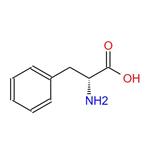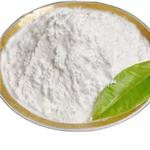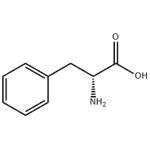- D-Phenylalanine
-

- $0.00 / 1KG
-
2024-04-09
- CAS:673-06-3
- Min. Order: 1KG
- Purity: ≥98% HPLC
- Supply Ability: 1000KG
- D-Phenylalanine
-

- $200.00/ KG
-
2024-04-08
- CAS:673-06-3
- Min. Order: 1KG
- Purity: 99%
- Supply Ability: 20 tons
- D-Phenylalanine
-

- $0.00 / 1kg
-
2024-04-07
- CAS:673-06-3
- Min. Order: 0.10000000149011612kg
- Purity: 99
- Supply Ability: 20tons
|
| | D-Phenylalanine Chemical Properties |
| Melting point | 273-276 °C(lit.) | | Boiling point | 293.03°C (rough estimate) | | alpha | 33.5 º (c=2, H2O) | | density | 1.1603 (rough estimate) | | refractive index | 34 ° (C=2, H2O) | | storage temp. | Store at RT. | | solubility | Methanol (Slightly), Water (Slightly) | | form | Powder | | pka | 2.2(at 25℃) | | color | White to off-white | | Water Solubility | 27 g/L (20 ºC) | | Merck | 14,7271 | | BRN | 2804068 | | Stability: | Stable. Incompatible with strong oxidizing agents, acids, bases. | | InChIKey | COLNVLDHVKWLRT-MRVPVSSYSA-N | | LogP | 0.235 (est) | | CAS DataBase Reference | 673-06-3(CAS DataBase Reference) | | EPA Substance Registry System | D-Phenylalanine (673-06-3) |
| Hazard Codes | Xi,C | | Risk Statements | 34 | | Safety Statements | 24/25-45-36/37/39-27-26 | | WGK Germany | 3 | | RTECS | AY7533000 | | Hazard Note | Irritant | | TSCA | Yes | | HS Code | 29224995 | | Toxicity | TDLo orl-hmn: 500 mg/kg/5W-I:GIT JACTDZ 1(3),124,82 |
| | D-Phenylalanine Usage And Synthesis |
| Description | D-phenylalanine is an inhibitor of enzymes that inactivate enkephalins. Enkephalins are naturally occurring morphine-like peptides that function to reduce pain. By blocking enzymes from degrading enkephalins, D-phenylalanine can reduce pain severity. Phenylalanine is the only amino acid other than methionine in which both isomers, L and D, are readily absorbed. DLPA is 50% D-phenylalanine and 50% L-phenylalanine, making it clinically useful as a neurotransmitter precursor and as a potential pain mediator.
Phenylalanine is found in three different forms. The natural form, found in food, is also called L-phenylalanine. There’s also a synthetic form, D-phenylalanine, which is very similar to the natural version. Both of these forms come with their own unique benefits, but if you want to get the most out of them, you’ll want to look at the third form: DL-phenylalanine. This form combines both the “L” and “D” forms, creating a supplement with the benefits of both types. | | In vitro | The binding of D-Phenylalanine to carboxypeptidase A confers anion sensitivity upon the function of the enzyme by breaking the hydrogen bond between the active site base, Glu-270, and the zinc-bound water molecule. | | In vivo | D-Phenylalanine (500 mg/kg p.o.) produces a small increase in aversive threshold which is not statistically significant and not naloxone reversible. Acetylsalicylic acid (200 mg/kg p.o.) but not zomepirac sodium (200 mg/kg p.o.) in combination with D-phenylalanine (500 mg/kg) produces a small statistically significant increase in aversive threshold. | | Biological Activity | DL-Phenylalanine (DLPA) is marketed as a nutritional supplement for its purported analgesic and antidepressant activities. DL-Phenylalanine is a mixture of D-phenylalanine and L-phenylalanine. The reputed analgesic activity of DL-phenylalanine may be explained by the possible blockage by D-phenylalanine of enkephalin degradation by the enzyme carboxypeptidase A. The mechanism of DL-phenylalanine's supposed antidepressant activity may be accounted for by the precursor role of L-phenylalanine in the synthesis of the neurotransmitters norepinephrine and dopamine. Elevated brain levels of norepinephrine and dopamine are thought to have an antidepressant effect. D-Phenylalanine is absorbed from the small intestine and transported to the liver via the portal circulation. A small amount of D-phenylalanine appears to be converted to L-phenylalanine. D-Phenylalanine is distributed to the various tissues of the body via the systemic circulation. It appears to cross the blood–brain barrier less efficiently than L-phenylalanine, and so a small amount of an ingested dose of D-phenylalanine is excreted in the urine without penetrating the central nervous system.
| | Benefits | D-phenylalanine (DPA) decreases pain by blocking the enzymes that break down the body's natural painkillers. Clinical studies suggest DPA may inhibit some types of chronic pain.
Certain amino acids have been found to raise pain thresholds and increase tolerance to pain. One of these, a synthetic amino acid called D-phenylalanine (DPA), decreases pain by blocking the enzymes that break down endorphins and enkephalins, the body's natural pain-killing chemicals. DPA may also produce pain relief by other mechanisms, which are not well understood.
In animal studies, DPA decreased chronic pain within 15 minutes of administration and the effects lasted up to six days. It also decreased responses to acute pain. These findings have been independently verified in at least five other studies. Clinical studies on humans suggest DPA may inhibit some types of chronic pain, but it has little effect on most types of acute pain. | | Side Effects | Phenylalanine is found in many protein-containing foods and is “generally recognized as safe” by the Food and Drug Administration (FDA).
The amount of this amino acid found in foods should not pose a risk for otherwise healthy individuals.
What’s more, few or no side effects are generally observed at supplement doses of 23–45 mg per pound (50–100 mg per kg) of body weight.
However, it may be best for pregnant women to avoid taking phenylalanine supplements. | | Description | D-Phenylalanine, also known as D-alpha-Amino-beta-phenylpropionic acid, is a kind of non-proteinogenic amino acid. The biological function of D-phenylalanine remains unclear. However, it has certain anti-depressant, analgesic activities and pharmacological activity at niacin receptor II. The mechanism action of its analgesic activity seems to originate from its inhibition of enkephalin degradation by the carboxypeptidase A. Enkephalins are part of your body’s natural pain relief system. When they are broken down by enkephalinase, this contributes to the sensation of pain. D-Phenylalanine is specifically thought to be beneficial for reducing feelings of chronic pain. D-phenylalanine has been used with mixed results to treat chronic pain, including pain caused by rheumatoid arthritis. The primary use of D-phenylalanine as a health supplement is the relief of discomfort. | | Chemical Properties | White crystalline powder | | Uses | D-Phenylalanine, the stereoisomer of L-Phenylalanine (P319415) has been used in the synthesis of Schaeffer’s acid analogues as important structures in tuberculostatic design. They exhibit the ability to inhibit Mycobacterium tuberculosis type II dehydroquinase. | | Definition | ChEBI: D-phenylalanine is the D-enantiomer of phenylalanine. It is a phenylalanine and a D-alpha-amino acid. It is a conjugate base of a D-phenylalaninium. It is a conjugate acid of a D-phenylalaninate. It is an enantiomer of a L-phenylalanine. It is a tautomer of a D-phenylalanine zwitterion. | | General Description | D-phenylalanine appears as needles or prisms. | | Air & Water Reactions | Water soluble. Aqueous solutions are weakly acidic. | | Reactivity Profile | D-alpha-Amino-beta-phenylpropionic acid may be light sensitive. D-alpha-Amino-beta-phenylpropionic acid reacts with strong oxidizing agents, acids and bases. . Act as weak acids in solution. | | Fire Hazard | Flash point data for D-alpha-Amino-beta-phenylpropionic acid are not available, however D-alpha-Amino-beta-phenylpropionic acid is probably combustible. | | Pharmacokinetics | D-Phenylalanine is the synthetic dextro isomer of phenylalanine, an essential amino acid with anti-depressant and analgesic activities. D-Phenylalanine is converted into tyrosine and tyrosine in turn is converted into L-dopa, norepinephrine, and epinephrine, three key neurotransmitters. As a result this agent is associated with elevated levels of the neurotransmitters dopamine and norepinephrine in the brain, which may alleviate symptoms of depression. In addition, as an inhibitor of enkephalinase, which metabolizes endorphins, D-phenylalanine may be used to treat chronic pain through blocking the break down of endorphins (natural pain killers). | | Safety Profile | Mildly toxic by intraperitoneal route. Human systemic effects by ingestion: nausea, hypermotility, diarrhea. When heated to decomposition it emits toxic fumes of NOx. | | References | https://www.alfa.com/en/catalog/A10572/
https://en.wikipedia.org/wiki/Phenylalanine
Christianson, D. W., et al. "Binding of D-phenylalanine and D-tyrosine to carboxypeptidase A. " Journal of Biological Chemistry264.22(1989):12849-53. |
| | D-Phenylalanine Preparation Products And Raw materials |
|